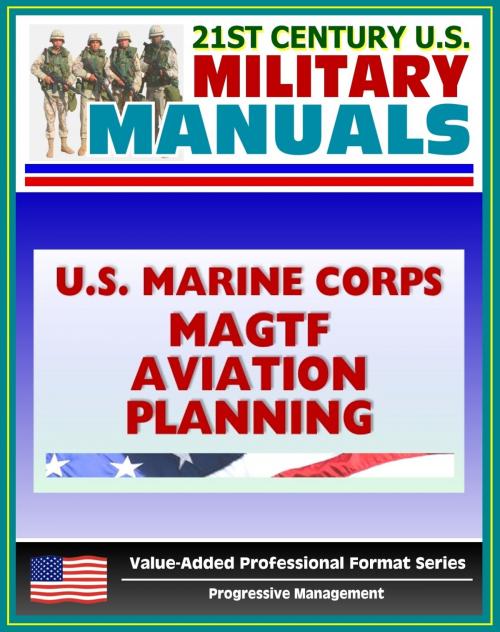21st Century U.S. Military Manuals: U.S. Marine Corps (USMC) MAGTF Marine Air-Ground Task Force Aviation Planning Fleet Marine Force Manual (FMFM) 5-70
Nonfiction, History, Military, Naval, Americas| Author: | Progressive Management | ISBN: | 9781465753489 |
| Publisher: | Progressive Management | Publication: | February 8, 2012 |
| Imprint: | Smashwords Edition | Language: | English |
| Author: | Progressive Management |
| ISBN: | 9781465753489 |
| Publisher: | Progressive Management |
| Publication: | February 8, 2012 |
| Imprint: | Smashwords Edition |
| Language: | English |
Part of our value-added professional format series of U.S. military manuals, this U.S. Marine Corps manual covers Marine air-ground task force aviation planning.
Fleet Marine Force Manual (FMFM) 5-70, MAGTF Aviation Planning, provides Marine air-ground task force (MAGTF) planners with a foundation for aviation planning. Part I addresses planning relationships and responsibilities for a MAGTF operating autonomously, within the structure of a naval expeditionary force, or in a joint environment. Part II provides specific planning considerations for the separate functions of Marine aviation.
FMFM 5-70 provides the MAGTF-level planner and the aviation combat element (ACE)-level planner with an authoritative reference for aviation planning.
A MAGTF conducting maneuver warfare is a machine with many moving and potentially conflicting parts that operate at great speed. It continually adjusts itself to seize the fleeting opportunities presented in the modern battlespace. Aviation planning must be careful and deliberate to orchestrate these moving parts. The need to accomplish deliberate planning within a time limit has led to the use of three different planning frameworks: concurrent, parallel, and detailed. These frameworks complement each other to produce a timely planning cycle.
Concurrent planning is planning accomplished simultaneously by two or more echelons of the same command or by corresponding echelons of different commands. The skillful use of concurrent planning helps to compensate for the time spent on detailed planning by successive echelons. The detailed planning process can become stalled at any echelon due to lack of information. Subordinate commanders can begin concurrent planning prior to the issuance of written planning documents by using information announced at planning conferences and briefings. Planning memorandums, warning orders, and outline plans provide additional means to disseminate fragmentary planning information. Concurrent planning is kept on track by a common understanding of the commander's intent.
As a bonus, this reproduction includes the Marine Corps Manual, the basic publication of the United States Marine Corps issued by the Commandant of the Marine Corps and approved by the Secretary of the Navy - sold separately for $7.99. It is a regulatory publication for the Department of the Navy as defined in U.S. Navy Regulations. The Marine Corps Manual is designed primarily for use by Marine Corps commanders and their staffs, Navy officers exercising command over Marines, the staff of the Commandant of the Marine Corps, and the staffs of the bureaus and offices of the Navy Department. Contents: Chapter 1 - General Administration And Management * Chapter 2 - Manpower * Chapter 3 - Operations And Readiness * Chapter 4 - Logistics
The manual describes the Marine Corps mission and functions: The Marine Corps shall be organized, trained, and equipped to: (1) Provide Fleet Marine Forces of combined arms, together with supporting air components, for service with the United States Fleet in the seizure or defense of advanced naval bases and for the conduct of such land operations as may be essential to the prosecution of a naval campaign. (2) Provide detachments and organizations for service on armed vessels of the Navy, and security detachments for the protection of naval property at naval stations and bases. (3) Develop, in coordination with the Army, Navy, and Air Force, the doctrines, tactics, techniques, and equipment employed by landing forces in amphibious operations.
Part of our value-added professional format series of U.S. military manuals, this U.S. Marine Corps manual covers Marine air-ground task force aviation planning.
Fleet Marine Force Manual (FMFM) 5-70, MAGTF Aviation Planning, provides Marine air-ground task force (MAGTF) planners with a foundation for aviation planning. Part I addresses planning relationships and responsibilities for a MAGTF operating autonomously, within the structure of a naval expeditionary force, or in a joint environment. Part II provides specific planning considerations for the separate functions of Marine aviation.
FMFM 5-70 provides the MAGTF-level planner and the aviation combat element (ACE)-level planner with an authoritative reference for aviation planning.
A MAGTF conducting maneuver warfare is a machine with many moving and potentially conflicting parts that operate at great speed. It continually adjusts itself to seize the fleeting opportunities presented in the modern battlespace. Aviation planning must be careful and deliberate to orchestrate these moving parts. The need to accomplish deliberate planning within a time limit has led to the use of three different planning frameworks: concurrent, parallel, and detailed. These frameworks complement each other to produce a timely planning cycle.
Concurrent planning is planning accomplished simultaneously by two or more echelons of the same command or by corresponding echelons of different commands. The skillful use of concurrent planning helps to compensate for the time spent on detailed planning by successive echelons. The detailed planning process can become stalled at any echelon due to lack of information. Subordinate commanders can begin concurrent planning prior to the issuance of written planning documents by using information announced at planning conferences and briefings. Planning memorandums, warning orders, and outline plans provide additional means to disseminate fragmentary planning information. Concurrent planning is kept on track by a common understanding of the commander's intent.
As a bonus, this reproduction includes the Marine Corps Manual, the basic publication of the United States Marine Corps issued by the Commandant of the Marine Corps and approved by the Secretary of the Navy - sold separately for $7.99. It is a regulatory publication for the Department of the Navy as defined in U.S. Navy Regulations. The Marine Corps Manual is designed primarily for use by Marine Corps commanders and their staffs, Navy officers exercising command over Marines, the staff of the Commandant of the Marine Corps, and the staffs of the bureaus and offices of the Navy Department. Contents: Chapter 1 - General Administration And Management * Chapter 2 - Manpower * Chapter 3 - Operations And Readiness * Chapter 4 - Logistics
The manual describes the Marine Corps mission and functions: The Marine Corps shall be organized, trained, and equipped to: (1) Provide Fleet Marine Forces of combined arms, together with supporting air components, for service with the United States Fleet in the seizure or defense of advanced naval bases and for the conduct of such land operations as may be essential to the prosecution of a naval campaign. (2) Provide detachments and organizations for service on armed vessels of the Navy, and security detachments for the protection of naval property at naval stations and bases. (3) Develop, in coordination with the Army, Navy, and Air Force, the doctrines, tactics, techniques, and equipment employed by landing forces in amphibious operations.















